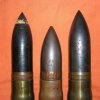Tony Williams
Well-Known Member
I have in my collection an AP loading of the usual 57 x 306R Hotchkiss case intended for the 6 pdr 8 cwt and 6 cwt tank guns, which features a shorter projectile than the naval base-fuzed Common Pointed type.
Since the tank gun was used more for engaging machine gun nests and other infantry features, I assume that a nose-fuzed HE was also issued? Can anyone provide details and a photo?
Since the tank gun was used more for engaging machine gun nests and other infantry features, I assume that a nose-fuzed HE was also issued? Can anyone provide details and a photo?
















